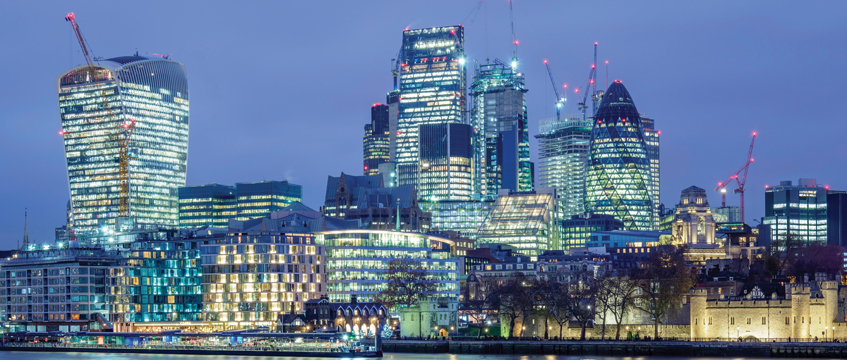Paris closes gap on London in foreign investment league
London remains the world’s top destination for foreign investment in financial and professional services, but a new report shows that Paris is pulling ahead on key indicators of global competitiveness, such as employment growth and office occupancy.
“Paris is not about to eclipse London as a global city, but it will start to eat our lunch,” said Alexander Jan, chief economic advisor to the London Property Alliance, which commissions the quarterly Global Cities Survey.
Now on its fifth edition, the report analyses London’s progress in dealing with, and recovering from, the Covid-19 pandemic compared with four of its world city competitors: New York, Paris, Berlin and Hong Kong.
London remains the world’s top destination for foreign investment in financial and professional services, but a new report shows that Paris is pulling ahead on key indicators of global competitiveness, such as employment growth and office occupancy.
“Paris is not about to eclipse London as a global city, but it will start to eat our lunch,” said Alexander Jan, chief economic advisor to the London Property Alliance, which commissions the quarterly Global Cities Survey.
Now on its fifth edition, the report analyses London’s progress in dealing with, and recovering from, the Covid-19 pandemic compared with four of its world city competitors: New York, Paris, Berlin and Hong Kong.
It shows that resurging demand and usage for offices in Paris, coupled with limited availability, have pushed the city’s vacancy levels down to 2.5%. This is well below London (8.8%) and Manhattan (21.9%), as New York in particular struggles with the impact of home working, crime and infrastructure challenges on its business districts. The robust performance of Paris’ office market reflects the comparative buoyancy of its financial and professional services sector and a structural under-supply of high-grade office space, the report said.
Central London’s vacancy rate is still historically high, but overall levels have seen no material change during 2022. Best-in-class sites with grade-A office space in central London are in high demand, however, recording a significantly lower vacancy rate of 3.5%. The West End’s vacancy rate reflects this, falling to 4.4%. In contrast, the City of London recorded a vacancy rate of 11.4%, driven by newly completed office stock.
Central London’s office market is helping to drive economic recovery, with high-quality West End workspaces recording higher headline rental growth than global peers (15% compared to pre-pandemic levels). But the report warns that Paris’ employment growth and public transport usage – as well as the city’s overall office occupancy levels – are marching ahead.
“We are now a year or so on from Covid restrictions being lifted, with the exception of Hong Kong, and we are starting to see a greater divergence in the performance of our five cities. On a number of criteria, Paris seems to be on the up a bit more than our other cities – most dramatically when you look at central Paris office vacancy,” Jan said.
“It’s striking that the New York vacancy rate is eight times that of Paris. And demand for public transport is 21% higher than in New York. The big headline finding for us is this divergence between cities, but it isn’t just about Paris versus New York. We urgently need to address the risk of London being outperformed,” Jan added.
“London has for a long time been the pre-eminent city among this group. New York has been its closest competitor, but it’s like a game of ‘grandma’s footsteps’. Other cities are now creeping up on London and we need to be clear about what we are asking government for to make sure London doesn’t fall behind.”
A key risks to the capital’s position includes the impact of Brexit, both on labour force ability and reducing the UK’s access to the single market relative to key global competitors such as the US.
“Unending industrial action also risks corroding London’s international standing and we need urgent government action to help address these problems. Otherwise, we will see our competitors such as Paris continue to benefit as we risk insidious decline,” Jan said.
Among the solutions the LPA is lobbying for to boost London’s attractiveness to both visitors and businesses is sustained investment in the capital’s public environment and infrastructure.
“Partnership between the public and private sectors, as well as innovative investment models (such as TIF), can help fund much-needed investment at a time of restrained public spending,” the report says.
It also calls for urgent business rate reform and the return of tax-free shopping for overseas visitors.
London developer perspective: Mike Hussey, chief executive, Almacantar
“I don’t really include Paris or Berlin in a “global city” definition anymore. The occupancy is as much cultural and [about] lease structure as anything else, and the Paris market is not showing lower vacancy in CBD because of global issues – they are largely domestic. I suspect there was an injection of pace from Brexit, with some companies choosing it as the Euro hub, but not exclusively – and I expect the big users to stay focused on London.
“Ever since I was at Canary Wharf, the pundits have peddled Frankfurt (now Berlin) and Paris as serious competition. In all honesty they are ‘regionally’ competitive, but not globally (Frankfurt is tiny, so is Berlin). If the government continues to turn its back on international business, it will gravitate to New York and Singapore, I suspect. However, London’s geographic position, time zone, infrastructure, language, legal framework (precedent), cultural attractions, benign politics and strong housing stock will take many generations to over-run, and realistically it has been a global trading hub since AD44 and that is unlikely to change. Just watch the capital flows which are consistently allocated to London, in the top three global cities for most of the past three decades.”
More from the report: employment trends
Paris recorded the strongest sustained increase in demand for workers in 2022, with the French capital seeing a 5% increase in employment numbers compared with 2021. This figure puts the city’s new pay-rolled employee growth ahead of London (4.3%) as well as New York and Hong Kong, where employment is yet to surpass pre-pandemic benchmarks. London continued to record the biggest increase in newly-employed professionals out of all UK regions.
Despite a small increase in growth (0.1%) reported for the UK economy in November last year, recessionary fears in the wake of the September’s mini-Budget saw the UK capital experience a fall in labour demand in the latest quarter. While still 26% above pre-pandemic levels’ demand for workers in Q4 2022, vacancies were down five percentage points on the previous quarter. In comparison, Paris recorded its highest level of post-pandemic employment growth; vacancies are now up 42% compared with the January 2020 benchmark. In reaching its highest rate of labour demand, Paris appears to be a significant beneficiary of the UK and London’s economic and workforce uncertainty post-Brexit.
Public transport recovery
The recovery of public transport usage in London saw passenger volumes on the Underground network reach 80% of pre-pandemic levels by November 2022. Notwithstanding industrial action, London remained ahead of New York City, where Q4 subway ridership came in at just 65% of the pre-pandemic benchmark. But once again, Paris has seen the strongest recovery in its rail network, with passenger numbers averaging 86% of pre-Covid benchmark levels in the last part of 2022.
To send feedback, e-mail julia.cahill@eg.co.uk or tweet @EGJuliaC or @EGPropertyNews
Image © Karol Kozlowski/imageBROKER/Shutterstock











